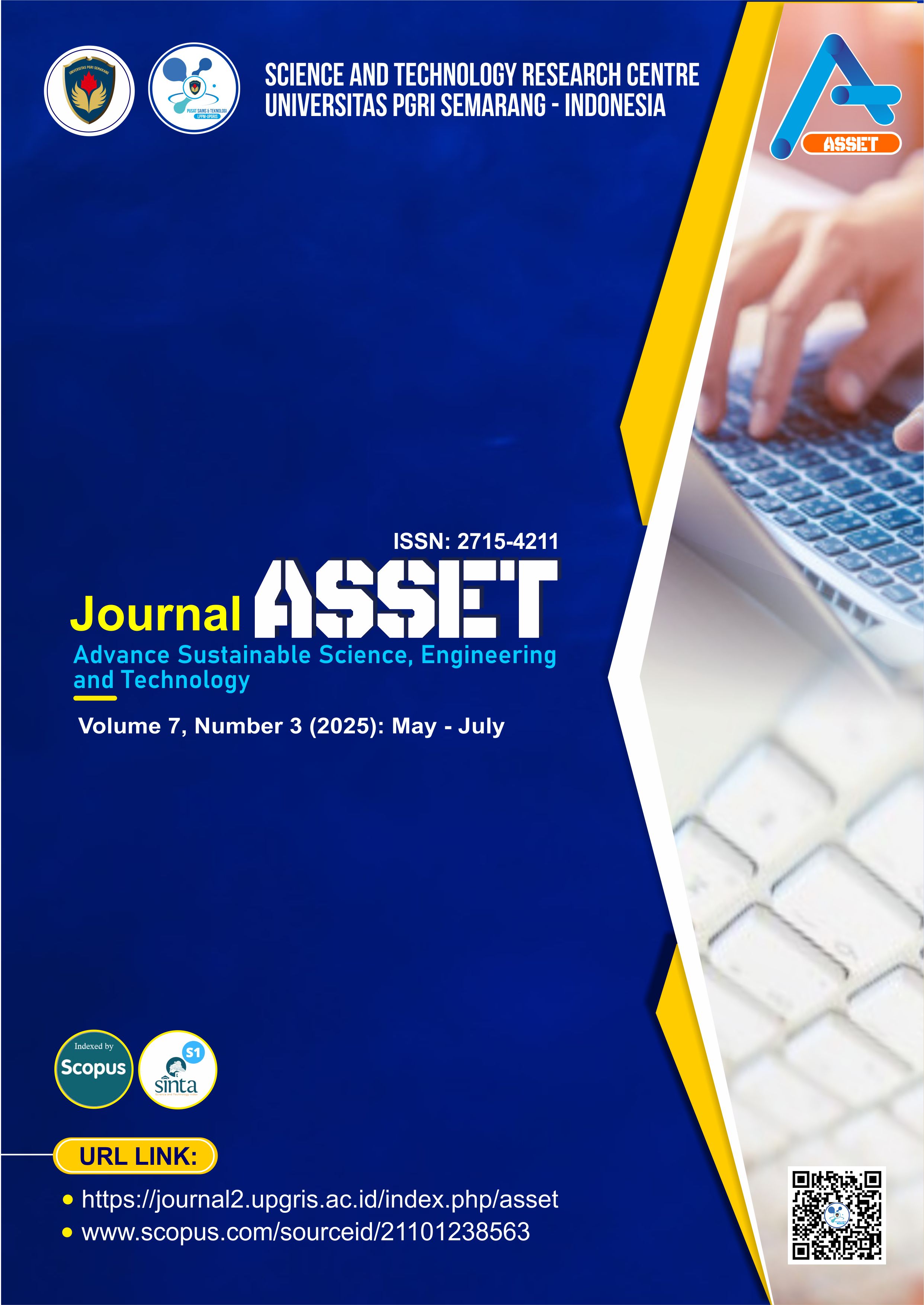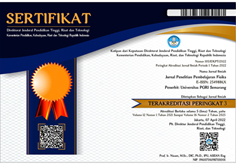High-Resolution Smart Card-Based OD Matrix for Optimizing Jakarta’s LRT Operations
DOI:
https://doi.org/10.26877/asset.v7i4.2254Keywords:
Light Rail Transit (LRT), smart card, transit analysis, LRT performance metrics, transit demand estimation, urban mobilityAbstract
Efficient urban mobility is essential to support transportation planning and policy. However, traditional methods are often limited in data resolution, lacking the ability to describe passenger movement dynamics in detail. This study aims to analyze passenger mobility patterns using high-resolution tap-in/tap-out data from the closed-loop LRT system in Jakarta during January-February 2025. The methods used include constructing an origin-destination (OD) matrix based on 185,512 trip records, as well as temporal and spatial analysis of passenger flows. The results showed the existence of peak hour patterns on weekdays (07.00-09.00 and 17.00-19.00), trip spikes on weekends and holidays (14.00-18.00), and high flow concentrations at interchange stations such as Velodrome and North Boulevard. While data from the closed system allows for accurate trip tracking, potential data gaps due to technical errors or user behavior remain a concern for long-term analysis. The findings suggest that high-resolution smart card data can provide operationally relevant insights for short-term decision-making, such as schedule adjustments or fleet allocation. However, for long-term strategic planning, integration with predictive models and other planning tools remains necessary. This research fills a gap in the literature by showing that even limited-duration datasets can be leveraged to effectively support data-driven transportation management.
References
[1] N. Novitasari and T. Sudibyo, “Analysis of the predicted road level of service (case study: Jakarta Inner City Toll Road—Bekasi Raya section),” Journal of Civil and Environmental Engineering, vol. 5, no. 1, pp. 1–16, May 2020. doi: 10.29244/jsil.5.1.116.
[2] Presidential Regulation of the Republic of Indonesia No. 55: Jakarta, Bogor, Depok, Tangerang, and Bekasi (Jabodetabek) Transportation Master Plan, 2018.
[3] L. Wang, F. Lu, B. Han, Q. Zhang, and C. Zhang, “Simulation based optimization of transport efficiency of an urban rail transit network,” Applied Sciences, vol. 13, no. 3, Art. no. 1471, January 2023. doi: 10.3390/app13031471.
[4] Y. Niu, X. Li, J. Zhang, X. Deng, and Y. Chang, “Efficiency of railway transport: A comparative analysis for 16 countries,” Transportation Policy, vol. 141, pp. 42–53, September 2023. doi: 10.1016/j.tranpol.2023.07.007.
[5] Y. Le, M. Oka, and H. Kato, “Efficiencies of the urban railway lines incorporating financial performance and in-vehicle congestion in the Tokyo metropolitan area,” Transportation Policy, vol. 116, pp. 343–354, February 2022. doi: 10.1016/j.tranpol.2021.12.017.
[6] D. Pan, L. Zhao, Q. Luo, C. Zhang, and Z. Chen, “Study on the performance improvement of urban rail transit system,” Energy, vol. 161, pp. 1154–1171, October 2018. doi: 10.1016/j.energy.2018.07.067.
[7] Y. Li, Z. Chen, and P. Wang, “Impact of high speed rail on urban economic efficiency in China,” Transportation Policy, vol. 97, pp. 220–231, October 2020. doi: 10.1016/j.tranpol.2020.08.001.
[8] M. Lyu, H. Geng, J. V. P. P. Dias, and M. Miyatake, “Multi-objective control of urban railway speed with deep reinforcement learning,” in Proc. IEEE Int. Conf. Electrical Systems for Aircraft, Railway, Ship Propulsion and Road Vehicles & International Transportation Electrification Conf. (ESARS ITEC), Naples, Italy, 26–29 November 2024, pp. 1–6. doi: 10.1109/ESARS ITEC60450.2024.10819904.
[9] X Yang, X. Li, B. Ning, and T. Tang, “A survey on energy efficient train operation for urban rail transit,” IEEE Transactions on Intelligent Transportation Systems, vol. 17, no. 1, pp. 2–13, January 2016. doi: 10.1109/TITS.2015.2447507.
[10] R. Abe and H. Kato, “What led to the establishment of a rail-oriented city? Determinants of urban rail supply in Tokyo, Japan, 1950–2010,” Transportation Policy, vol. 58, pp. 72–79, August 2017. doi: 10.1016/j.tranpol.2017.05.004.
[11] S. Y. Phoong, S. W. Phoong, S. Moghavvemi, and K. H. Phoong, “User perception on urban light rail transit,” Civil Engineering and Architecture, vol. 7, no. 6A, pp. 43–49, December 2019. doi: 10.13189/cea.2019.071405.
[12] S. Spears, M. G. Boarnet, and D. Houston, “Driving reduction after the introduction of light rail transit: Evidence from an experimental control group evaluation of the Los Angeles Expo Line,” Urban Studies, vol. 54, no. 12, pp. 2780–2799, September 2017. doi: 10.1177/0042098016657261.
[13] F. Ferbrache and R. Knowles, “City boosterism and place making with light rail transit: A critical review of light rail impacts on city image and quality,” Geoforum, vol. 80, pp. 103–113, January 2017. doi: 10.1016/J.GEOFORUM.2017.01.013.
[14] D. Alefari, A. D. Saleh, and M. Haggag, “The impact of light rail transit on urban development in Dubai, UAE,” Sustainability, vol. 16, no. 17, Art. no. 7705, September 2024. doi: 10.3390/su16177705.
[15] R. D. Knowles and F. Ferbrache, “Evaluation of wider economic impacts of light rail investment on cities,” Journal of Transport Geography, vol. 54, pp. 430–439, June 2016. doi: 10.1016/j.jtrangeo.2015.09.002.
[16] X. Wang, Y. Zhang, and J. Zhang, “Large scale origin–destination prediction for urban rail transit network based on graph convolutional neural network,” Sustainability, vol. 16, no. 23, Art. no. 10190, November 2024. doi: 10.3390/su162310190.
[17] M. Mohammed and J. Oke, “Origin-destination inference in public transportation systems: A comprehensive review,” International Journal of Transportation Science and Technology, vol. 12, no. 1, pp. 315–328, 2023. doi: 10.1016/j.ijtst.2022.03.002.
[18] M. Mamei, N. Bicocchi, M. Lippi, S. Mariani, and F. Zambonelli, “Evaluating origin–destination matrices obtained from CDR data,” Sensors, vol. 19, no. 20, p. 4470, 2019. doi: 10.3390/s19204470.
[19] K. Du, X. Guo, L. Li, J. Song, Q. Shi, M. Hu, and J. Fang, “Traffic prediction in time-series, spatial-temporal, and OD data: A systematic survey,” Journal of Traffic and Transportation Engineering (English Edition), 2025. doi: 10.1016/j.jtte.2025.03.001.
[20] M. K. El Mahrsi, E. Come, L. Oukhellou, and M. Verleysen, “Clustering smart card data for urban mobility analysis,” IEEE Transactions on Intelligent Transportation Systems, vol. 18, no. 3, pp. 712–728, March 2017. doi: 10.1109/TITS.2016.2600515.
[21] A. Ali, J. Kim, and S. Lee, “Travel behavior analysis using smart card data,” KSCE Journal of Civil Engineering, vol. 20, no. 4, pp. 1532–1539, May 2016. doi: 10.1007/s1220501516940.
[22] T. Tang, A. Fonzone, R. Liu, and C. Choudhury, “Multi-stage deep learning approaches to predict boarding behaviour of bus passengers,” Sustainable Cities and Society, vol. 73, Art. no. 103111, October 2021. doi: 10.1016/j.scs.2021.103111.
[23] L. He, M. Trépanier, and B. Agard, “Space–time classification of public transit smart card users’ activity locations from smart card data,” Public Transport, vol. 13, no. 3, pp. 579–595, October 2021. doi: 10.1007/s12469021002740.
[24] M. Bagchi and P. R. White, “The potential of public transport smart card data,” Transportation Policy, vol. 12, no. 5, pp. 464–474, September 2005. doi: 10.1016/j.tranpol.2005.06.008.
[25] M. Wasesa et al., “Using smart card data to develop origin–destination matrix-based business analytics for bus rapid transit systems: Case study of Jakarta, Indonesia,” Journal of Management Analytics, vol. 11, no. 3, pp. 471–494, July 2024. doi: 10.1080/23270012.2024.2371518.
[26] M. K. El Mahrsi, E. Come, L. Oukhellou, and M. Verleysen, “Clustering smart card data for urban mobility analysis,” IEEE Transactions on Intelligent Transportation Systems, vol. 18, no. 3, pp. 712–728, March 2017. doi: 10.1109/TITS.2016.2600515.
[27] D. B. Bellastuti and R. Fathurrahman, “Application of smart mobility in the DKI Jakarta transportation system with KRL commuter line transportation mode,” Asian Journal of Social and Humanities, vol. 2, no. 03, pp. 535–542, 2023. doi: 10.59888/ajosh.v2i03.155.
[28] B. Rahmani, A. M. Moghaddam, and M. Maghrebi, “Forecasting demand fluctuations of public bus transit during special events and adverse weather conditions through smart card data analysis,” Travel Behaviour and Society, vol. 40, p. 101033, 2025. doi: 10.1016/j.tbs.2025.101033
[29] X. Tian, C. Zhang, and B. Zheng, “Crowding prediction of in-situ metro passengers using smart card data,” arXiv preprint, arXiv:2009.02880, 2020. doi: 10.48550/arXiv.2009.02880.
[30] V. D. Silva, A. Finamore, and R. Henriques, “On the role of multi-objective optimization to the transit network design problem,” arXiv preprint, arXiv:2201.11616, 2022. doi: 10.48550/arXiv.2201.11616.
[31] C. Cucuzzella, J. Owen, S. Goubran, and T. Walker, “A TOD index integrating development potential, economic vibrancy, and socio-economic factors for encouraging polycentric cities,” Cities, vol. 131, p. 103980, 2022. doi: 10.1016/j.cities.2022.103980.
[32] H. Liu, Y. Li, J. Li, B. Hou, and S. Zhao, “Optimizing the location of park-and-ride facilities in suburban and urban areas considering the characteristics of coverage requirements,” Sustainability, vol. 14, no. 3, p. 1502, 2022. doi: 10.3390/su14031502.
[33] R. L. Abduljabbar, S. Liyanage, and H. Dia, “The role of micro-mobility in shaping sustainable cities: A systematic literature review,” Transportation Research Part D: Transport and Environment, vol. 92, p. 102734, 2021. doi: 10.1016/j.trd.2021.102734.











